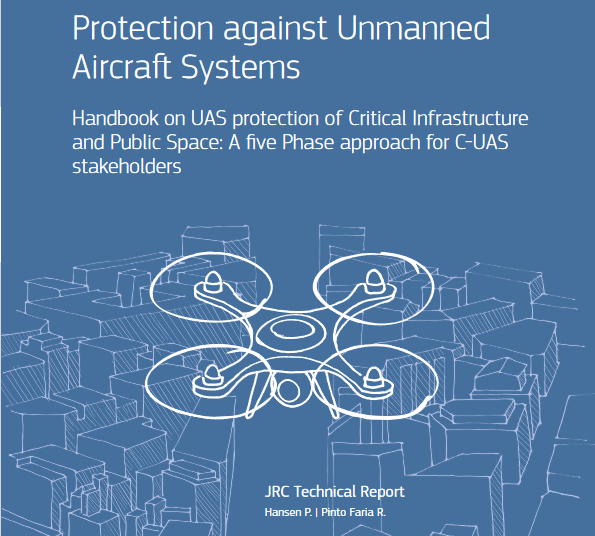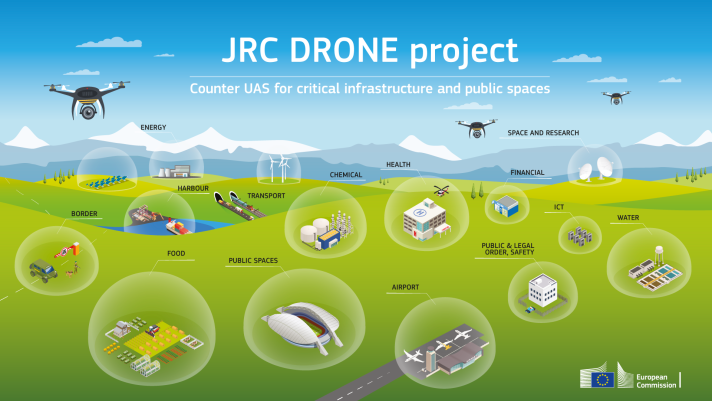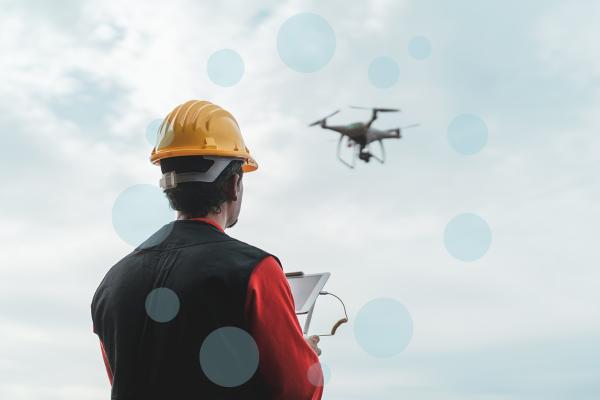- Contributes to EC priorities:
The project looks at security aspects concerning the use of UAS and services built upon. The project will review active and passive counter measure technologies and how these technologies can be utilized to ensure the security of citizens and critical infrastructure. The creation of a living lab will investigate counter UAS technologies and how these can be applied in reality. The implementation will cover planning, preparation and implementation of a solution considering detection, identification and combatting.
Why are drone services important for Europe
The development of drone (unmanned aircraft systems - UAS) services supported by a competitive industry can strongly support Europe’s twin transition to green and digital economy, contribute to the post-COVID 19 recovery and to the future resilience of the EU economy.
The European Green Deal, calls for the reduction of greenhouse gas emissions as well as the development of digitalisation.
What has been accomplished so far
The Commission adopted in 2020 a strategy for sustainable and smart mobility, which included the intention to also “adopt a ‘Drone Strategy 2.0’ setting out possible ways to guide the further development of this technology and its regulatory and commercial environment“.
The EU needs to ensure the safe and efficient development of a drone ecosystem, addressing other related societal concerns such as safety, security, privacy and environmental protection while simultaneously ensuring a sustainable economic environment for the European drone industry to grow.
A first European regulatory framework is now in place since 2019. However, further and new action is needed at EU level because the sector is developing rapidly with new innovative ways of using drones emerging at a fast pace. They require an assessment of the regulatory and enabling framework to ensure that these new services can thrive in the EU internal market.
Future role of JRC and Commission
Related technologies such as radiofrequency communication, Artificial Intelligence, advanced sensors and improvements in power sources are opening new prospects. Conversely, the fact that customised drones can also be used for illegal purposes should be addressed. It is important that Europe safeguards its open strategic autonomy in this area.
For the competitiveness of the European drone eco-system as well as Europe’s defence capabilities, reaping synergies between the civil, including counter-drones technologies and military use of drones is an important success factor.
The application of UAS is becoming very popular in many areas with services in agriculture, transport, survey, surveillance etc., and it will be a growing economic sector in the coming years.
JRC has been collaborating and will continue to collaborate with the several policy DGs and different stakeholders involved offering its expertise to connect the dots in this fast-moving domain both in the drone and counter drone domains.
Commission sets out measures to tackle potential threats from civilian drones
How are technologies tested
JRC Geel site will be used as living lab to study counter-drone technologies and how these technologies can be applied in real-world settings. The lab setup will cover the planning, preparation, and implementation of a solution. It will also cover detection, tracking, identification, neutralisation and the integration of stakeholders and processes. The scope of implementation for the living lab will include integration with manned and unmanned traffic-management systems, most notably U-space. The living lab will also study how machine learning and artificial intelligence can be integrated in order to improve the overall performance of a counter-drone solution.
In the medium term, this JRC living lab will be developed into a counter-drone centre of excellence.

The Handbook on UAS protection of Critical Infrastructure and Public Space demonstrates a five-phase approach providing the key aspects for efficiently securing an area against drone threats, as follows:
- Getting started: Setting the principles, goals and requirements for the Counter-UAS solution
- Risk analysis: Investigating, analysing and documenting the site’s UAS-driven threats and establishing a response plan
- Solution design: Matching business needs with potential solution architectures
- Solution implementation: Installation and testing considerations of the solution
- Solution operation: Operating, maintaining and updating the solution
The living lab will be setup using the methodology of the JRC handbooks. As a first step the airspace over and around the JRC Geel site has been declared a Geozone according to the regulations. Geozone details and access conditions.

The Handbook on UAS Risk Assessment and Principles for Physical Hardening of Buildings and Sites provides insight on available physical protective security measures focusing on their typology,
performance and constraints. It explores their advantages over more sophisticated technological solutions, focusing on the fact that they are cost-efficient, multifunctional and not vulnerable to technical failures.
The handbook also illustrates a robust risk assessment that provides a comprehensive understanding of the parameters that influence the likelihood of manifestation of a UAS-driven security incident and the potential resulting consequences. Criteria are determined for reducing the amount of subjectivity to such a process, which is a prerequisite for selecting the most cost-efficient methodologies for mitigating the impact of an attack.
Related links
- Drone Strategy: Creating a large-scale European drone market (europa.eu)
- European regulatory framework
- Handbook on UAS protection of critical infrastructure and public space : a five phase approach for C-UAS stakeholders
- Handbook on UAS risk assessment and principles for physical hardening of buildings and sites
- JRC Geel Geozone details and access conditions.
- How to become a UAS (drone) pilot. Drone operators & pilots | EASA (europa.eu)


